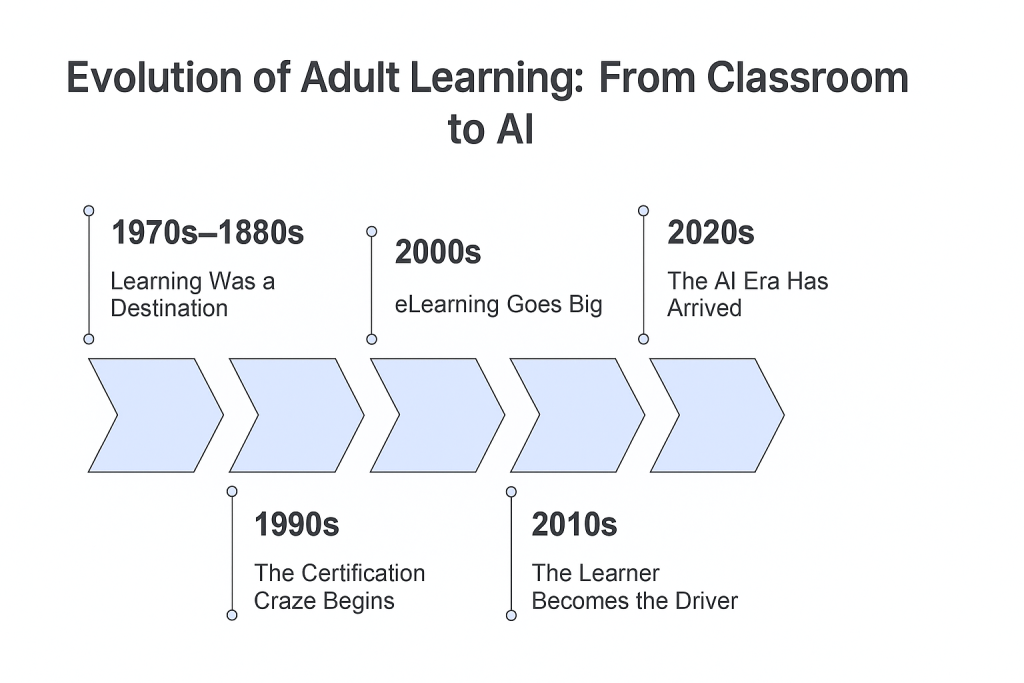
The way adults learn has been flipped on its head over the past five decades. What once involved overhead projectors and printed manuals is now powered by AI tutors, code simulators, and personalized learning bots. In a world of constant disruption, continuous learning isn’t a luxury anymore — it’s survival.
Let’s take a step back and explore how adult learning has transformed — and how the IT and software industries, in particular, have led the charge.
📚 50 Years of Learning: The Timeline of Transformation
🔹 1970s–1980s: Learning Was a Destination
Back then, adult education mostly meant night classes, workshops, and seminars. Employers occasionally sent employees for external training. Everything was classroom-based and instructor-led, with knowledge flowing one way — from trainer to learner. It was rigid, structured, and inflexible.
🔹 1990s: The Certification Craze Begins
As tech entered the mainstream, so did vendor-driven certifications. Microsoft, Cisco, and CompTIA became household names for IT professionals. Learning was still offline, but the shift to skill-based credentials had begun.
🔹 2000s: eLearning Goes Big
With the internet boom, self-paced learning exploded. Flash courses, SCORM packages, and corporate LMS platforms became the norm. Companies started investing seriously in employee upskilling — but learning remained passive and often lacked interactivity.
🔹 2010s: The Learner Becomes the Driver
Smartphones, social media, and platforms like YouTube and LinkedIn Learning turned the spotlight on the learner. Microlearning, peer learning, and MOOCs redefined how adults consume knowledge. Learning started to follow people — not the other way around.
🔹 2020s: The AI Era Has Arrived
With the rise of tools like ChatGPT, GitHub Copilot, and AI-driven LXPs, learning has become real-time, contextual, and hyper-personalized. Learners now want:
- Instant answers
- Just-in-time knowledge
- Support within tools they already use
Forget courses. Learners today want “learning moments.”
💻 IT & Software Learning: Always a Step Ahead
The IT industry didn’t just adapt to this learning revolution — it led it.
🧠 Then:
- Certifications like MCSE, CCNA, and OCP ruled resumes.
- Training meant bootcamps, manuals, and long-form videos.
- Learning was often a means to a job switch or promotion.
⚙️ Now:
- IT pros are learning on the fly — inside GitHub, VS Code, or even Teams.
- AI tools are co-developers, not just assistants.
- The “course” is being replaced by hands-on labs, code sandboxes, and AI-powered mentoring.
The industry has shifted from just-in-case learning to just-in-time mastery. That’s a massive leap.
🌟 What’s Coming Next?
Here’s a quick peek into the (near) future:
- 🤖 AI-powered mentors who offer real-time feedback on your code, presentations, or even negotiation style.
- 🧱 Stackable micro-credentials that build your skills like Lego bricks.
- 🕶️ Immersive learning with AR/VR — think virtual cybersecurity labs or architectural design in 3D.
- 🧠 Agentic learning environments: AI agents curating, teaching, nudging, and evolving with you.
Learning will be so deeply embedded into work that it won’t even feel like “training” anymore.
💬 Final Word: It’s Time to Rethink Learning
The rules of adult learning have changed. Whether you’re in tech, healthcare, finance, or manufacturing — the need to learn fast and learn often is real. For organizations, that means moving from compliance training to capability building.
At OPTIMISTIK INFOSYSTEMS, we help organizations stay ahead of the curve. From building GenAI-ready tech teams to enabling business leaders to think with AI — our customized learning journeys are built for the now.
👉 If your teams are still stuck in “old-school learning,” let’s talk. The future is waiting — and it learns fast.